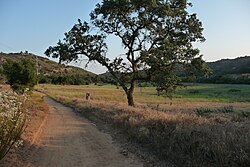|
Valley Center, California
Valley Center is a census-designated place (CDP) in San Diego County, California, United States. The population was 9,277 at the 2010 census. HistoryIn the late 1860s, the area now known as Valley Center was referred to as Bear Valley, and was the habitat of the now-extinct California grizzly bear, pictured on the flag of California. In 1866, the largest grizzly ever recorded in California was shot and killed in Valley Center.[4] GeographyAccording to the United States Census Bureau, the CDP has a total area of 98.7 square miles (256 km2), all land. ClimateAccording to the Köppen climate classification system, Valley Center has a warm-summer Mediterranean climate abbreviated "Csa" on climate maps. On March 30, 2023, a tornado warning was issued by the National Weather Service which is extremely rare for this part of the US.[5] Demographics2010At the 2010 census Valley Center had a population of 9,277. The population density was 178.3 inhabitants per square mile (68.8/km2). The racial makeup of Valley Center was 2,285 (73.1%) White with 64.0% of the population non-Hispanic whites, 58 (0.9%) African American, 188 (2.0%) Native American, 295 (3.2%) Asian, 16 (0.2%) Pacific Islander, 584 (16.0%) from other races, and 425 (4.6%) from two or more races. 27.8% of the population was Hispanic.[6][7] The census reported that 9,243 people (99.6% of the population) lived in households, 27 (0.3%) lived in non-institutionalized group quarters, and 7 (0.1%) were institutionalized. There were 1,000 households, 1,120 (37.3%) had children under the age of 18 living in them, 1,035 (67.8%) were opposite-sex married couples living together, 43 (7.1%) had a female householder with no husband present, 142 (4.7%) had a male householder with no wife present. There were 127 (4.2%) unmarried opposite-sex partnerships, and 21 (0.7%) same-sex married couples or partnerships. 239 households (15.4%) were one person and 193 (6.4%) had someone living alone who was 65 or older. The average household size was 3.08. There were 2,389 families (79.6% of households); the average family size was 3.38. The age distribution was 1,250 people (24.3%) under the age of 18, 414 people (8.9%) aged 18 to 24, 694 people (20.9%) aged 25 to 44, 1,003 people (33.4%) aged 45 to 64, and 539 people (12.5%) who were 65 or older. The median age was 42.1 years. For every 100 females, there were 100 males. For every 100 females age 18 and over, there were 99.4 males. There were 2,228 housing units at an average density of 117.7 per square mile, of the occupied units 1,739 (80.6%) were owner-occupied and 581 (19.4%) were rented. The homeowner vacancy rate was 1.7%; the rental vacancy rate was 2.8%. 2,364 people (79.4% of the population) lived in owner-occupied housing units and 1,879 people (20.3%) lived in rental housing units. 2000At the 2000 census there were 1,323 people, 415 households, and 719 families in the CDP. The population density was 59.1 inhabitants per square mile (22.8/km2). There were 415 housing units at an average density of 66.0 per square mile (25.5/km2). The racial makeup of the CDP was 85.69% White, 0.52% African American, 2.84% Native American, 1.35% Asian, 0.19% Pacific Islander, 6.45% from other races, and 2.96% from two or more races.[8] Of the 415 households 38.8% had children under the age of 18 living with them, 68.4% were married couples living together, 6.7% had a female householder with no husband present, and 20.5% were non-families. 15.6% of households were one person and 6.1% were one person aged 65 or older. The average household size was 3.01 and the average family size was 3.33. The age distribution was 29.6% under the age of 18, 6.5% from 18 to 24, 25.2% from 25 to 44, 27.4% from 45 to 64, and 11.4% 65 or older. The median age was 39 years. For every 100 females, there were 102.2 males. For every 100 females age 18 and over, there were 101.1 males. The median household income was $64,649 and the median family income was $68,388. Males had a median income of $50,440 versus $35,199 for females. The per capita income for the CDP was $24,071. About 5.8% of families and 3.6% of the population were below the poverty line, including 5.7% of those under age 18 and 10.6% of those age 65 or over. Arts and cultureMuseumsValley Center History Museum was founded in 2003. Exhibits include a stagecoach which served as a Civil War ambulance, provided local transportation, and was featured in a number of Western motion pictures; a preserved California Grizzly Bear; and memorabilia.[9][10] EventsOn Memorial Day weekend, the town remembers fallen veterans at the Valley Center Stampede Rodeo and Festival.[11] Every year, the town celebrates their western heritage with the Valley Center Western Days Parade and Country Fair.[12] GovernmentIn the California State Legislature, Valley Center is in the 38th Senate District, represented by Democrat Catherine Blakespear, and in the 75th Assembly District, represented by Republican Carl DeMaio.[13] In the United States House of Representatives, Valley Center is in California's 50th congressional district, represented by Democrat Scott Peters.[14] Valley Center also serves as the seat of the tribal governments of the Rincon Band of Luiseño Indians and the San Pasqual Band of Diegueno Mission Indians reservations, east of the CDP area.[15][16] EducationAlmost all of it is in the Valley Center-Pauma Unified School District. A small section of the CDP extends into the Escondido Union School District and the Escondido Union High School District.[17] Notable people
References
External links |
||||||||||||||||||||||||||||||||||||||||||||||




